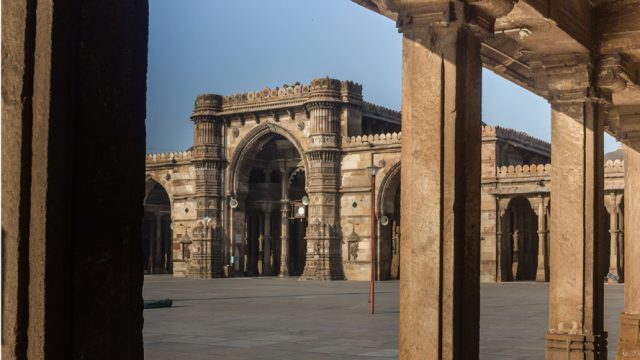At first glance, Ahmedabad, the former capital of Gujarat, is a flourishing commercial hub ruling western India. But tucked within its folds, especially in the ‘walled city’ is an almost 600-year old architectural heritage that won Ahmedabad the coveted World Heritage Site tag from UNESCO. Take a walk through Ahmedabad to know more about the city and its legacy.
While there is plenty to see and do in Ahmedabad (or Amdavad as the local people call it), Gujarat’s flourishing trading hub, a heritage walk in the ‘walled city’ has now become a must on travellers’ itinerary. In July 2017, Ahmedabad became the first city in India, and the only one so far, to win the UNESCO World Heritage Site tag. Although it has come a long way from the citadel that Ahmed Shah – presumably a nobleman from the Delhi Sultanate — established on the banks of the Sabarmati River in 1411 AD, according to the UNESCO citation, the city “presents a rich architectural heritage from the sultanate period, notably the Bhadra citadel, the walls and gates of the Fort city and numerous mosques and tombs as well as important Hindu and Jain temples of later periods.”
One of the most popular walks is the morning tour conducted by the Amdavad Municipal Corporation (AMC). The walk starts from the early 19th century Swaminarayan temple in Kalupur. Participants have to assemble at the designated spot at 7.45 am for a short audio-visual introduction. The walk commences at 8am and covers nearly 20 spots before ending at the 15th century Jama Masjid. The walk covers nearly two kilometres, with frequent stops.
During the walk, you will cover several ‘pol’, the urban legacy that played a significant role in clinching the UNESCO award for Ahmedabad. Although a shadow of their glorious past, the ‘pol’ are gated neighbourhoods that were born out of a sense of community feeling and safety. Usually, every ‘pol’ was lived in by people belonging to the same caste, community or profession. The main road gave way to narrow meandering streets lined with homesteads, some richly ornamented. Each ‘pol’ had a few common features, such as a place of religious worship, a community well and a bird feeder.

Other interesting stops on the way include royal mausoleums — Badshah no Hajiro and Rani no Hajiro, havelis, temples, etc. The walk will take you through Manek Chowk, which wakes up as a vegetable market, sees brisk business in jewellery in the afternoon, and in the evening turns into a food street. To enjoy the array of street food available here, you will have to go in the evening, usually after eight pm. Do not forget to ask your guide about the story of the magician saint after whom the Chowk is named.
The walk concludes at the Jama Masjid, built during the reign of Ahmed Shah, the founder of the city. An example of Gujarat’s ‘sultanate architecture’, the intricate calligraphy on the columns and carvings in the yellow sandstone mosque and arcades are not to be missed. According to the Gujarat Tourism website, “In its Indo-Saracenic architecture, the mosque also contains many syncretic elements not necessarily obvious to the viewer: some of the central domes are carved like lotus flowers, closely related to the typical domes of Jain temples; and some of the pillars are carved with the form of a bell hanging on a chain, in reference to the bells that often hang in Hindu temples.”
Usually, an evening tour is also available. It starts from the 16th century Sidi Saiyad Mosque (famous for its lattice-work windows) at Lal Darwaja at 8.45 pm and concludes at Manek Chowk at 11.30pm.
The walks, priced variously, can be booked online at https://heritagewalkahmedabad.com/.
The House of MG, which runs two boutique heritage hotels in Ahmedabad, offers heritage walks around Ahmedabad to its guests. Their two-hour Breakfast Walk, starting at 7.30am is available from October to March. The one-hour long Night Walk is held round the year. You may also avail their Audio Guided Walk. More details available on https://houseofmg.com/explore/heritage-walks/.
Getting There: Ahmedabad is well-connected through its international airport, about 10km away from the city centre. The main railway station is located in the Kalupura area. By road, Ahmedabad is well connected with the major hubs in Gujarat.




